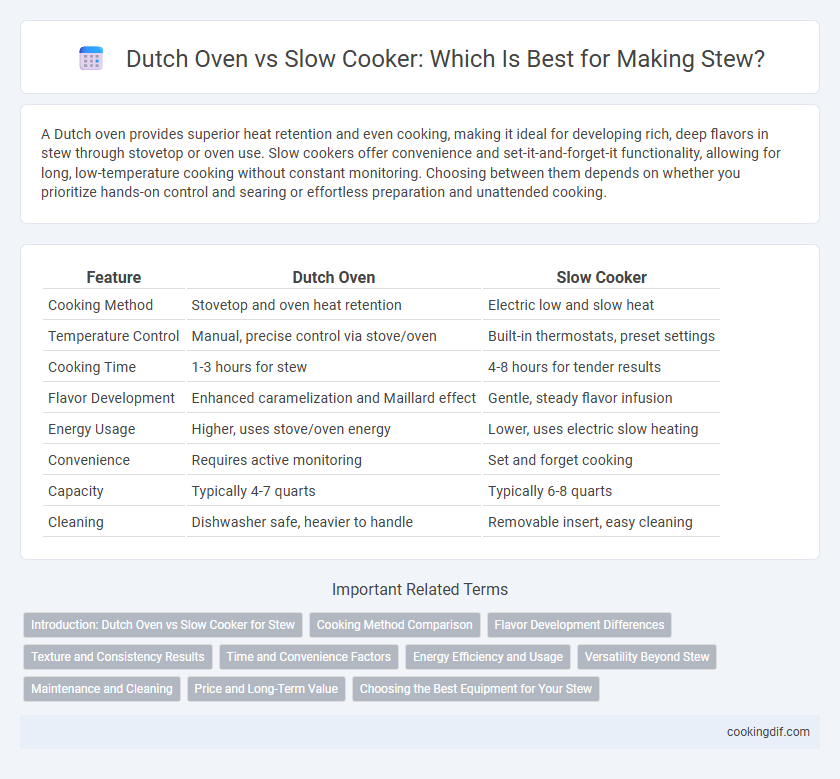A Dutch oven provides superior heat retention and even cooking, making it ideal for developing rich, deep flavors in stew through stovetop or oven use. Slow cookers offer convenience and set-it-and-forget-it functionality, allowing for long, low-temperature cooking without constant monitoring. Choosing between them depends on whether you prioritize hands-on control and searing or effortless preparation and unattended cooking.
Table of Comparison
| Feature | Dutch Oven | Slow Cooker |
|---|---|---|
| Cooking Method | Stovetop and oven heat retention | Electric low and slow heat |
| Temperature Control | Manual, precise control via stove/oven | Built-in thermostats, preset settings |
| Cooking Time | 1-3 hours for stew | 4-8 hours for tender results |
| Flavor Development | Enhanced caramelization and Maillard effect | Gentle, steady flavor infusion |
| Energy Usage | Higher, uses stove/oven energy | Lower, uses electric slow heating |
| Convenience | Requires active monitoring | Set and forget cooking |
| Capacity | Typically 4-7 quarts | Typically 6-8 quarts |
| Cleaning | Dishwasher safe, heavier to handle | Removable insert, easy cleaning |
Introduction: Dutch Oven vs Slow Cooker for Stew
Dutch ovens provide exceptional heat retention and even cooking, ideal for developing rich, deep flavors in stew. Slow cookers offer convenience through programmable settings, allowing for unattended, low-temperature simmering that tenderizes meat effectively. Choosing between a Dutch oven and a slow cooker depends on desired cooking control, texture, and time investment for the perfect stew.
Cooking Method Comparison
Dutch ovens use direct heat from stovetops or ovens, allowing for precise temperature control and even heat distribution, ideal for searing meat before slow cooking stew. Slow cookers operate at low temperatures over extended periods, relying on consistent, enclosed heat to break down tough ingredients without the need for active stirring. The Dutch oven's capacity for high heat and versatile cooking techniques contrasts with the slow cooker's convenience and energy efficiency in slow, unattended cooking.
Flavor Development Differences
A Dutch oven promotes superior flavor development in stew through even heat distribution and the ability to sear ingredients, enhancing caramelization and Maillard reactions. Slow cookers maintain low, consistent temperatures that tenderize meat but often result in less complex, more uniform flavors. The high-heat browning in a Dutch oven creates deeper, richer taste profiles compared to the gentle, prolonged cooking environment of a slow cooker.
Texture and Consistency Results
Dutch ovens provide superior heat retention and even cooking, resulting in stew with a rich, caramelized texture and thick, well-developed consistency. Slow cookers maintain a steady low temperature, producing tender meat and well-blended flavors but often yield a softer texture and thinner broth compared to Dutch ovens. Choosing between the two depends on desired texture: Dutch ovens excel in creating robust, hearty stews with depth, while slow cookers offer convenience and consistently tender results.
Time and Convenience Factors
Dutch ovens offer faster cooking times due to direct stovetop and oven heat control, which allows precise temperature adjustments essential for developing rich stew flavors. Slow cookers provide unmatched convenience by enabling hands-free, all-day cooking with consistent low heat, ideal for busy schedules and unattended meal preparation. Choosing between the two hinges on balancing the desire for time-efficient cooking against the need for ease and minimal monitoring during the stew-making process.
Energy Efficiency and Usage
A Dutch oven offers superior heat retention and even cooking, enabling lower stovetop or oven temperatures and reducing overall energy consumption during stew preparation. Slow cookers operate at low wattages over extended periods, making them energy-efficient for unattended, long-duration cooking with minimal heat loss. Choosing between the two depends on whether you prioritize rapid heat distribution and versatile cooking methods or steady, low-energy slow cooking for flavor development.
Versatility Beyond Stew
A Dutch oven offers exceptional versatility beyond stew, functioning as an oven-safe pot suitable for baking, roasting, and frying due to its heavy cast iron construction and ability to withstand high temperatures. Slow cookers excel in convenient, hands-off cooking with programmable timers and low-energy use but are mostly limited to simmer and slow-cook recipes. The Dutch oven's versatility makes it ideal for a wide range of cooking techniques, while the slow cooker caters to ease and timing precision for stew and similar dishes.
Maintenance and Cleaning
Dutch ovens, typically made from cast iron or enameled cast iron, require thorough hand washing to prevent rust and preserve their seasoning, avoiding abrasive cleaners to maintain their non-stick surface. Slow cookers feature removable ceramic or metal inserts that are often dishwasher-safe, simplifying cleaning and reducing maintenance time. Both methods demand drying equipment completely after washing; however, Dutch ovens need occasional reseasoning while slow cookers benefit from regular inspection of electrical components for safety.
Price and Long-Term Value
Dutch ovens typically require a higher upfront investment, ranging from $70 to $200, but offer superior durability and versatility that justify their cost over time. Slow cookers are generally more affordable, priced between $30 and $100, yet may need replacement every few years due to electronic component wear. For long-term value, a Dutch oven's cast iron construction provides consistent heat retention and multi-functional use, making it a cost-effective choice for stew enthusiasts.
Choosing the Best Equipment for Your Stew
A Dutch oven offers superior heat retention and even cooking, ideal for browning ingredients and developing deep flavors in stew through stovetop and oven use. Slow cookers provide convenient, low-temperature, hands-off cooking, perfect for tenderizing tougher cuts of meat over several hours with minimal monitoring. Choosing the best equipment depends on your desired cooking style, time availability, and flavor complexity for the stew.
Dutch oven vs slow cooker for stew equipment Infographic

 cookingdif.com
cookingdif.com